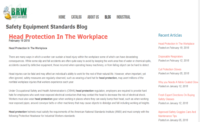How do we get workers to do what’s right—even when no one is looking? No one plans to go to work and be injured or cause someone else to be injured. Families want their loved ones to return home each day in the same condition as when they left for work. So why do companies and workers take risks that expose themselves or others to harm?
A safety officer for a publicly traded company told me that when he does a planned inspection, the compliance rate is in the 80 to 90 percent range, and when inspections are unplanned, compliance rates are closer to 25 or 30 percent. Are you nodding your head or shaking it?
Safety is in Everyone’s Best Interest
A concept so simple and wise, yet somehow overlooked until an accident occurs.
The deck is stacked against the safety team who hear these common excuses:
- Safety policies cut into productivity and profit margins
- Dismissive attitude towards safety in general
- Time is money–speed before safety
- Accidents–something that happens to other people–not to me
- Peer pressure to disregard safety rules
- Inconvenient and unneeded rules made up by people in an office
Overcoming this resistance is a tall mountain to climb and yet there are companies taking on the challenge.
Safety is Everyone’s Responsibility
The message must be clear and unwavering. Safe workplaces are no accident.
There is no such thing as a freak accident–only an accident waiting to happen. Serious injuries and fatalities are not only devastating to the individual, but they can destroy companies and impact those who depend on them for their livelihood. Even a stellar record for minor safety injuries may not be predictive of the potential for a serious accident. The causation of serious accidents is often quite different than those involving minor injuries.
Identifying risks, developing policies and procedures, educating and training and a long-term view are all very important aspects of a safety culture. The next steps are equally critical and also the most likely to be overlooked when workloads begin to heat up. Supervision, inspection and measurement are the cornerstones in most successful companies that hold especially true for safety compliance. A well respected leader in the drywall supply business has a quote that he uses to describe this concept, “People respect—what we expect—if we inspect.”
“You can’t manage what you can’t measure” is core to Lean Construction. When workers see management with no plan in place to measure compliance, it is human nature to revert to old behaviors. Simply having a set of safety guidelines in place without measuring compliance is like posting speed limit signs that say it’s the law, but sorry, no police available for enforcement, drive at your own risk.
There is an even more pervasive way that we sabotage the company safety message. When the policy and the core values of the company are safety first, we mean it, we live it, but then we use profits as the measuring stick for compensation, raises, performance reviews and bonuses. The message is received loud and clear and informs every decision a worker may make regarding safety.
How Do We Level the Playing Field?
One of the greatest external pressures in the business is when you’re trying to do everything right: investing money, developing a first rate safety culture and your team goes up against a competitor who is spending exactly zero on safety. Together, we can change this.
Does your customer know and appreciate what you are doing to make the job safer for everyone? This is the key. If your company is investing time and money and creating a strong safety culture, you are bringing value to every job and not just for your own company and employees. This benefit filters down to every man, woman and child connected to the project, directly and indirectly. Making certain that your customer knows about and understands the value of a safety culture is the best defense against any competition for whom safety is a non-issue or lip service. When you can explain to your customer, and they can explain to their customer, why an investment in safety is in their best interest, now you have their attention. Most importantly, the playing field is leveled and your competition will no longer be able to ignore safety because the customer will no longer accept the trade-off of a bargain price in return for risking potential tragedy.
Creating an Industry Safety Culture
Over the last number of years, I have had the privilege to meet and spend time with Drywall Suppliers, Drywall Installation Contractors, General Contractors, Risk Managers, Safety Officers, Engineers, Insurance Auditors, Technical and Research Representatives of gypsum manufacturers and people injured while either working on or visiting a construction site. Listening and learning from their very different perspectives has influenced my personal viewpoint about job safety in a way few other experiences could. Each brings a perspective that is important to the safety dialogue and yet there is not much interaction between these groups. I believe the opportunity for a strong industry safety culture exists if we can seek out the people who rarely get a seat at the safety table and listen to what they have to say. The feedback will be invaluable.
The intersection of profit and safety occurs when you have all the stake-holders coming together to discuss and decide what really matters and work hand in hand to form a consensus on the safest and most cost-effective method for each process with input that takes into consideration every step and includes feedback from a representative group for each part of the process. As standards are developed, expectations will rise and customers will not be comfortable working with companies that are unable to demonstrate a strong safety culture.
There are exceptional companies leading the way. These companies have gone all in and are breaking ground and raising expectations when it comes to safety in drywall supply, delivery and installation. Unwilling to sit back and wait for someone else to take the lead, they are out in front, investing time, money and resources to do the right thing. As an industry, it is in our best interest to support them.








Report Abusive Comment